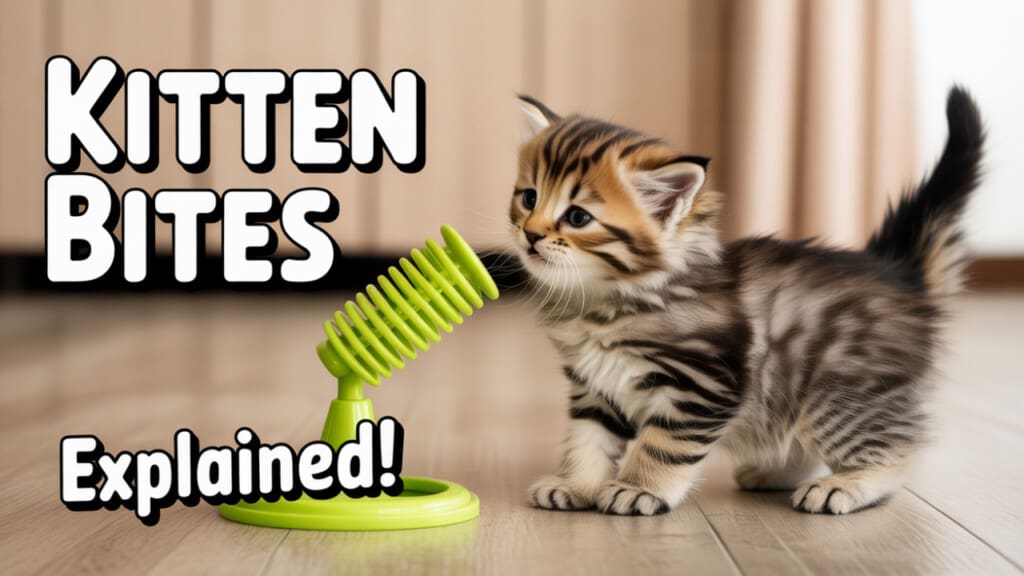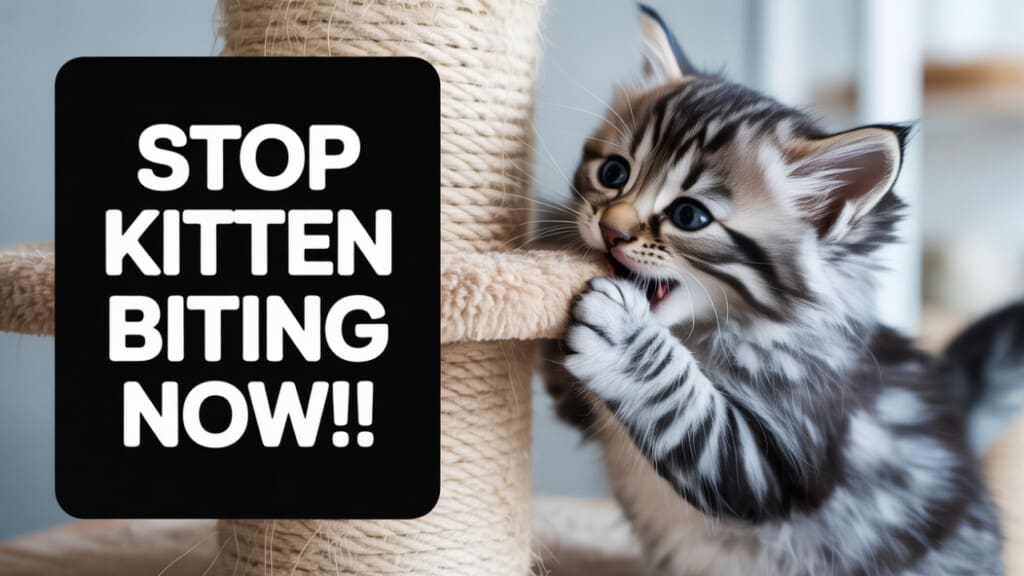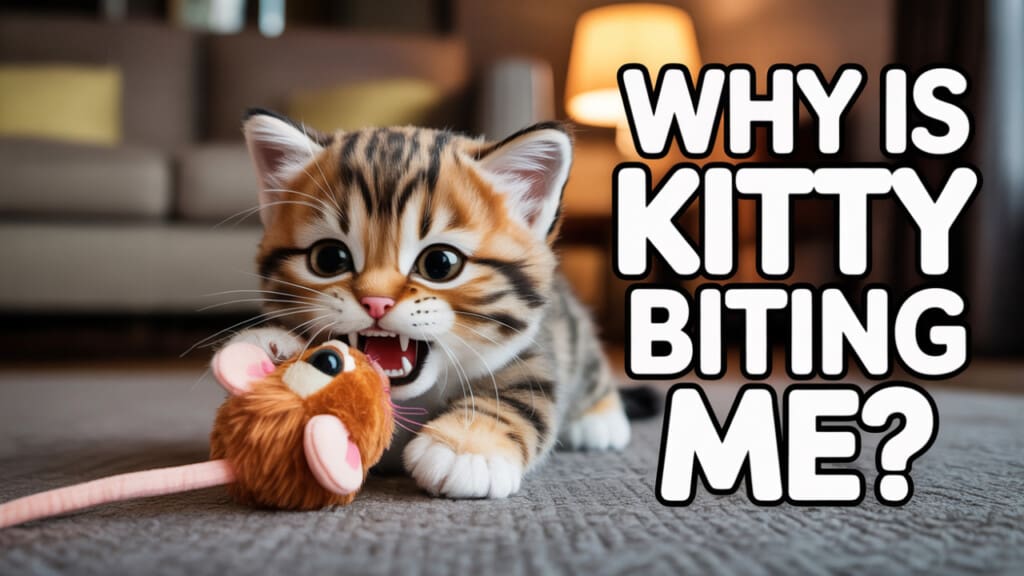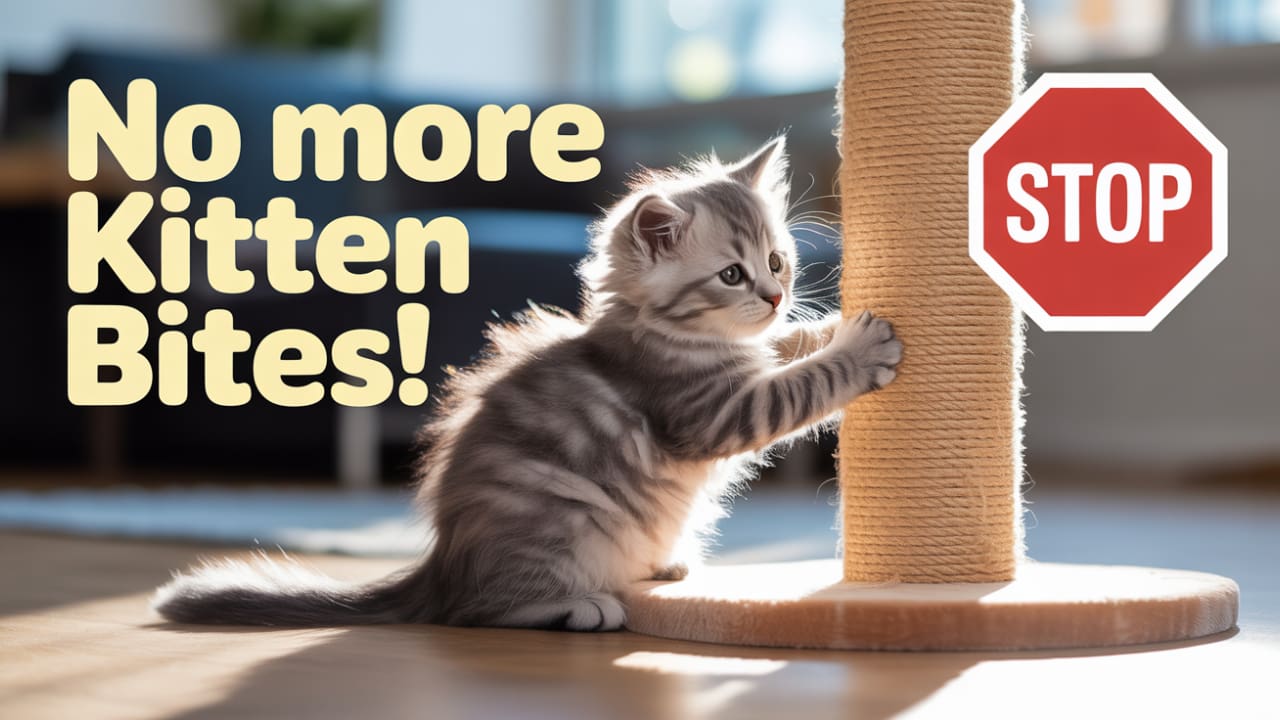How to Train a Kitten to Stop Biting: Expert Tips on Positive Reinforcement, Redirection, Toys, and Gentle Discipline Methods
Our kittens often like to cuddle and play with us. And it’s just not in our nature to reject such cuteness. But mid-play, the little bites can get painful. And the longer you play, the more bite marks you see on your hands.
So, how to train a kitten to stop biting? Is there a way to play with your furball without getting hurt?
Yes, actually. There is a way to do this. And it doesn’t really require any force or punishment. Our kittens are likely in the process of teething when they bite. Other reasons could be overstimulation or lacking socialization.
There are redirection techniques we can use via toys. And a daily training structure with positive reinforcement helps with that. Setting boundaries will then become a much easier process.
Fortunately, our kittens can usually adapt quite fast.
That said, we’ll need to understand that male kittens might need a slightly different approach. And we should learn how to distinguish between playful nips and pure aggression.
Sometimes, they are just showing affection, while other times, maybe not so much.
Kitten Aggression Level Quiz
Is your kitten's biting normal play behavior or something more serious? Take our 2-minute assessment to find out!
Recommended Training Approach:
- Redirect to appropriate toys during play
- Use positive reinforcement when playing gently
- Provide plenty of interactive play sessions
- Implement a consistent "stop play" response to bites
Why Do Kittens Bite? Understanding Feline Play Behavior and Teething

Our kittens bite for many different reasons. The one that’s most likely going on is teething. Teething usually begins around 3 weeks of age. And this teething process can last up to 6 months.
Your kittens’ teeth will fall out during this period, and adult teeth will emerge. And this is also the time when they feel like chewing and biting. It helps relieve a bit of that irritation.
Secondly, it’s their play behavior. Cats instinctively learn their survival skills play-fighting with other cats. When they are raised alongside others, your kittens are likely to develop this instinct.
Lastly, we should also know that biting can be due to overstimulation. Sometimes it might even be just that their energy needs are not met. Your kittens are energetic by nature. And it’s only fair that they want to let off some steam. And that usually results in those painful bites.
So, try to understand them so that you have an idea of how to get your kitten to stop biting.
Cat Dental Problems: What Vets Are Seeing in 2025
New research shows that dental disease is incredibly common in cats-affecting 50% to 90% of cats over 4 years old. Even younger cats can show signs of discomfort by biting more or chewing oddly to ease their pain.
Warning Signs That Need a Vet Visit:
- Drooling a lot, especially if you see blood in the saliva
- Pawing at the mouth or face
- Struggling to swallow or dropping food while eating
- Yellow or brown buildup on the teeth (tartar)
- Avoiding dry food or swallowing it whole without chewing
According to the latest studies, 68% of cats over three years of age show some degree of dental disease, with periodontitis being the most commonly diagnosed condition affecting 15.2% of cats annually in the UK
How to Train a Kitten to Stop Biting: Positive Reinforcement Techniques

Learning how to train your kitten not to bite isn’t exactly rocket science. But it’s best if you’re consistent with your guidance and feed your kittens with timely feedback.
Positive reinforcement works best for your little ones. After all, you want to reward your babies for work well done, not punish them.
Rewards can be treats, praise, or even a quick play session. A good toy for playtime is a great reward. Our kittens, more often than not, just want to spend more fun time with us.
Clicker training is also useful. What you need to do is associate your clicks with a treat. And when your kitten does something desirable, you click and give them a reward. Over time, this lets them know which behaviors are acceptable or not.
You should keep the training sessions short. Repeat them every day and be patient. This will very likely generate good results.
How Can I Stop My Cat from Biting Me? How to Train a Kitten to Stop Biting

What about cats? No longer kittens. Grown cats. Their bites hurt a lot more after all.
If you want to stop your cat from biting, you’ll also need to know the reason behind the behavior. Your cats could be biting you because of overstimulation, fear, territorial response, or habits from kittenhood.
When you pet your cat, look out for signs like tail twitching, flattened ears, or even just their skin rippling. These might mean your cat is overstimulated. And you should give it a rest.
If your cat bites, stop right away. Don’t give them any more attention. Just walk away. You want your message to be clear. Biting equals no more interaction. Simple.
Don’t yell, don’t swat. You don’t want your cat to get stressed out or even defensive. They are no longer babies that can’t protect themselves.
You can try giving them soft chew toys to satisfy their natural hunting instincts. This is healthier and more controlled. And it increases playtime and environmental enrichment.
As to how to stop your kitten from biting, you’ll need to begin early. Redirection and positive reinforcement work like a charm when these furballs are still little.
How to Train a Kitten to Stop Biting Using Safe Redirection and Enrichment Toys
Again, for those of you who’re wondering how to make a kitten stop biting. They bite, most likely to explore their world. And it’s also their way of testing boundaries.
So, you’ll need to guide them from a young age. Let them know what behavior is acceptable through redirection and enrichment toys. Don’t scold or intervene physically.
When your kitten starts biting, immediately redirect their attention. Use a toy they like. A soft chew toy would be great. You can also try a feather wand or motorized prey toy. The latter could mimic the excitement of hunting.
Enrichment is just as important. The toys you choose should have different textures, shapes, and motions. You want to keep your kittens stimulated enough, mentally and physically. Some of these examples include puzzle feeders, interactive tunnels, and rotating toys.
Of course, your redirection effort must be consistent. You should praise your baby when they bite the toy instead of you. This may take some time, but your kitten is adaptable and will learn the association gradually.
Top 5 Budget Toys That Outperform Luxury Brands
When picking enrichment toys, look for products with the Veterinary Oral Health Council (VOHC) seal of acceptance. Using VOHC-approved toys regularly helps reduce the risk of periodontal disease in pets.
Some great budget-friendly toys that work better than expensive ones include:
- Cardboard egg cartons, which you can turn into puzzle feeders to give your kitten mental stimulation.
- Feather wands that help your kitten enjoy play and use their hunting instincts, while keeping your hands safe.
- Soft chew toys are perfect for teething relief, especially between 3 to 6 months.
- Interactive tunnels with different textures and hidden spaces for play.
- Rotating toys that keep kittens active and help prevent boredom-based biting.
You can easily make a DIY puzzle feeder at home. Just cut holes into a clean cardboard egg carton, put some kibble inside, and close it. Your kitten will have fun working to get the food, turning mealtime into fun and mental enrichment.
Experts suggest using toys with a mix of textures, shapes, and motions to keep your kitten playful and sharp. Be consistent-whenever your kitten chooses the toy instead of biting, give lots of praise.
How to Train a Kitten to Stop Biting: And How to Discipline a Kitten for Biting Without Causing Fear or Aggression
Yes, you need to discipline your kitten too. But it’s not in the way you’re thinking of right now. You need a gentle and consistent approach. What you want is to reinforce boundaries without hurting the bond between you and your baby. It’s a very delicate process.
First, use non-verbal cues and environmental feedback. You need to communicate with your kitten and let them know the limits. If they bite, withdraw. No hesitation needed. The signal will be very clear if it’s done immediately. It’s like saying, “No more fun for you,” without harsh treatment.
Second, you can use a verbal command. A simple “No” will suffice. You can even try a short hiss sound if you fancy natural feline communication. Don’t make it complicated. You want direct communication. You can then redirect your kitten to a chewable toy. It’s a straightforward concept. Human: no bite. Toys: bite.
Remember, consistency is needed. You want your kitten to associate one thing with another. So, provide patterns and avoid confusion. Discipline is about teaching boundaries, gently. Not control.
How to Train a Kitten to Stop Biting Through Consistent Daily Training Habits
Routine is probably the most important if you want to train your baby. Essentially the core to how to teach your kitten not to bite
If you respond the same way every time they bite, they’ll know, eventually. They’ll understand what behavior gets them treats or rewards, and what gets them the cold shoulder.
You can begin with short play sessions every day. Use interactive toys. Let them bite the toys, not your hands. If they bite, you withdraw. And repeat this every day. It’s a gentle and humane approach.
There’s also bite inhibition training. You do this by praising mouth contact. Minimal playful nipping is okay, but nothing should hurt. And if your kitten bites (especially if it’s rough), pull away. Stop the interaction. You can also try to calm them using treats or soothing tones.
Remember, your kitten may bite because they’re tired, hungry, or overstimulated. But if you routinize daily activities, you can minimize stress-induced biting. The goal is to try to make this a second nature for your baby.
Feline Ethology Breakthrough: What Wildcat DNA Reveals About Your Kitten’s Bite (2025 Study)
Key Genetic Findings
- Cats with short-type alleles were more likely to purr but also showed more stranger-directed aggression, especially in females.
- Male cats with short-type alleles had more directed calls or vocalizations.
- The study shows that domestication has increased certain alleles linked to behavior traits in cats.
Another study from Nature Scientific Reports looked at 19 cat breeds. It found that all breeds showed a genetic link between human-directed aggression and behavior. The heritability estimates ranged from 0.40 to 0.53, meaning behavior can be passed down through DNA.
Does Gender Matter? How to Make a Male Kitten Stop Biting
Both male and female kittens bite. There’s no question about that. But male kittens can be more energetic during play. And they are also usually more assertive.
It’s not exactly the kind of aggression we know of. It’s more of natural play aggression and early social development.
The approach is similar for making a male kitten stop biting. We need consistency, redirection, and positive reinforcement. But, we may need slightly more structured playtime. After all, they often have higher energy levels.
You can interact with them using wand toys, puzzle feeders, and soft chew toys. But try to avoid boredom-based biting behavior.
Neutering may help with hormonally driven behaviors. This includes rough play and persistent biting. It’s not a guaranteed solution, but some owners notice that there’s a drop in hyperactivity and mouthing after neutering.
How to Train a Kitten to Stop Biting: Will My Kitten Grow Out of Biting on Their Own?
Actually, yes. Many kittens do bite less as they grow older. After their teething stage, they become more mature, socially. By months 6 to 12, your kitten would’ve (more likely than not) developed better self-control.
Then again, this is not a surefire approach. You should give your kitten guidance if you want to reinforce or discourage certain habits.
And if you don’t start young, the habit might persist into adulthood. It’ll be much more difficult to correct those behaviors then.
Consistent training and redirection are important. Some behaviors may fade with age, but it’s never a good idea to gamble your way through your kitten’s life.
How to Train a Kitten to Stop Biting: When to Seek Help for Aggressive Biting in Cats
Unlike playful nipping, aggressive biting in cats is a serious issue. The reason could be fear, pain, territorial behavior, or even underlying medical problems.
You may notice some warning signs with aggressive biting. Watch out for hissing, growling, pinned ears, dilated pupils, or a defensive body posture.
If your cat is biting without anything provoking them or even responding violently to touch, it’s time you bring them to a vet or a feline behaviorist. It might be a physical issue like dental pain. It may also be a neurological or behavioral problem (e.g. redirected aggression or anxiety).
You’d want to intervene rather early. Aggressive biting can really come between you and your cat. You need to seek help from a professional to design a customized behavior plan.
Every Kitten (and Cat) Loves a Yummy Reward
Remember, your kitten or cat needs positive reinforcement to strengthen the bond between you. And the food or treats you feed them as a reward play a huge role.
You want to give your kitten something they’ll like and enjoy. But you also need to make sure that the food you give them is healthy enough. You don’t want a vet trip later down the line as an exchange for good behavior.
We like Dr. Elsey’s Freeze-Dried Shrimp Cat Treats and Freeze-Dried Chicken Cat Treats. They are high in protein, with a single ingredient that makes for a proper meal, no added fillers. So they are clean and very much safe for your little babies.
As for the company, Dr. Elsey’s was founded in 1987 by veterinarian Dr. Bruce Elsey and his wife Kathy. They’re known for their “pet over profit” approach, and have developed a number of science-backed products for solving real-world cat problems.
Dr. Elsey’s consistently puts your cat’s well-being over profit with a focus on producing trusted litter and premium quality food for all life stages. And they support shelters nationwide, even giving out free litters and funding cancer research. We love this company because they truly care about our furry friends.
FAQs About Kitten Biting and Training
1. How do I get my kitten to stop biting without being harsh?
Well, try redirection, be consistent, and use positive reinforcement. Don’t punish your furry friend. Teach them acceptable behavior with toys and daily structure instead.
2. How to discipline a cat for biting you?
First, remember to be gentle and consistent. Stop your interaction immediately if your cat bites. Then, redirect their attention to a toy. Don’t yell or use physical punishment. This can lead to fear or defensive aggression.
3. How do I train my cat not to play bite?
Reinforce gentle behavior. Stop your play when your cat bites. Use interactive toys instead of your hands to set boundaries. Be consistent and direct to help your cat learn what’s acceptable.
4. At what age do cats stop biting you?
Most kittens can outgrow biting between 6 and 12 months of age. This is more so the case if you teach them bite inhibition. Consistent training and socialization are also important.
5. How to tell off a cat for biting?
A firm but calm “no” or walking away is often enough. You want to give a clear signal that you do not tolerate biting. But be consistent with your response to reinforce the message.
6. Will a cat grow out of biting?
Some cats naturally do as they mature. If you don’t provide guidance, however, biting can persist into adulthood. If you want to get rid of the habit, training is important.
7. Why do kittens bite when playing?
It’s instinctive for them. It helps them practice hunting skills. And your kittens use their mouths to explore and interact. This is especially the case when they are teething or overstimulated.
8. Can teething cause increased biting in kittens?
Yes, teething discomfort is likely the cause of their chewing and biting. So, give your kitten chewable toys. These usually help soothe their gums and redirect the behavior.
9. How does redirection help stop kitten biting?
Redirection teaches your kittens that biting people ends the fun. It also tells them that biting toys equals continued play. This can help shape future behavior. It’s essentially reward-based learning.
10. What’s the difference between play biting and aggression?
Play biting is usually light. And the kitten’s body language should be relaxed. Aggressive biting is harder, and it’s more unpredictable. It may include growling, hissing, or defensive posturing.
11. Does neutering reduce biting in male kittens?
Yes, it may reduce hormonally driven behaviors like excessive biting in some male kittens. But for long-term improvement, you’ll still need consistent training and enrichment.
How to Train a Kitten to Stop Biting: Building Trust the Right Way
Still asking yourself the question, “How to teach my kitten not to bite?” Let’s do a brief recap.
Well, you need a lot of patience, understanding, and consistent, positive reinforcement to guide your kitten’s behavior. Training is not about punishment.
You have to understand and recognize the natural reasons for their biting. Then, use redirection and enrichment toys to help you set clear boundaries.
The techniques and resources here should help you address a good number of problems. Teething troubles or managing high-energy play? You should be more confident in handling these now.
With time and the right approach, you can and most likely will be able to stop your kitten’s biting. That’s one way to build a stronger, more trusting bond along the way.
Have you been bitten by your kitten before? What did you do to help? Comment down below and let us know!








